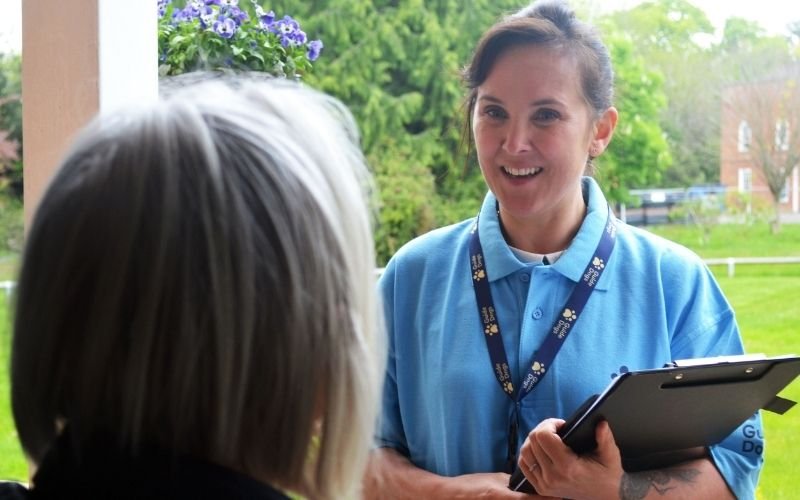Charities donors - What they REALLY think of fundraisers
As a professional fundraising agency, we spend a lot of time focusing on our fundraiser training, fundraisers performance and of course ensuring that our charity partners are represented in the best possible light.
But what about the perspective of the charities donors?
What do they think about face to face fundraisers who turn up on their doorstep or approach them on the street?
Exploring how donors feel is vital for understanding how professional fundraisers can improve their approach. It also has huge benefits for the charities themselves, whose long term battle is to curate as many donations as possible to function.
Our recent blogs ‘the psychology of donors’ and ‘reasons why people give to charity’ contain valuable research and information about what it is that actually makes people donate to charity - and how fundraisers can use that information to tailor their pitch.
But let’s look at it from the donors perspective.
Since we’ve all been thrown completely off track since 2019 when Covid first made its appearance, we’ve looked at older research first.
Back in 2016, the Chartered Institute of Fundraising (CIOF) and digital magazine UK Fundraising undertook research to reveal what donors think charity fundraisers do well and where key donor support for charities is.
Almost 3,000 people who donate to charitable causes and over 100 fundraisers were interviewed to hear their take on perceptions about face to face fundraising techniques.
Probably the most surprising result of the study was how fundraisers vastly underestimated how well door to door fundraising and street fundraising is actually received by the general public.
In fact, expectations of fundraising performance by the fundraisers were well below the actual results.
Contrary to expectations of fundraisers, who thought that over 55s would feel positively about door-to-door charity fundraising, survey results showed the opposite. In fact, what the over 55s preferred were street fundraisers and those working in private site venues.
Read more about private site venues for charity fundraisers here
In fact it was those aged 18-34 who were happiest with door to door, which again was the opposite of what fundraisers thought. They had assumed that the 18-34 age group would prefer street donors.
However, drilling a little deeper saw that 18-34s who donated more than £100 per year voted that street fundraising was the favourite.
Overall, females were shown to be less engaged with door to door, while men were less engaged with street fundraising.
What do donors like about door to door charity fundraising?
The most favourable of door to door fundraisers was shown as those who personalised their pitch to the donor
Other positive mentions included charity fundraisers having a ‘well-kept appearance’ and a ‘welcoming approach’, as did having topical authority on their subject
Fundraisers who could easily respond to queries as well as those who helped make the experience as convenient as possible also went down well
What do donors like about street fundraisers?
With street fundraisers, ‘ease of response’ ranked first as ‘most important’ feature
Next in line was ‘convenience’ followed by ‘relevance’
Donor’s thoughts on marketing communication
Overall, responses from donors showed that those aged 55 and over strongly preferred to receive email as a communication method.
Meanwhile, the most popular communication techniques for the 35-54s SMS messages.
This is an unfortunate blow for charities who, since 2018, have had to adhere to GDPR (General Data Protection Regulations) which means they must obtain permission first before contacting people.
‘High value’ donors enjoyed social media interaction which clearly shows the need for social media presence across the board, while press ads acted as encouragement for people to research further into charities by visiting websites.
So how should fundraisers and charities react to this research?
Clearly different channels among different age groups have different success rates, so taking time to understand the trends and fluctuations is surely valuable information.
If this research is to be acted upon, fundraisers working in public venues or on the street could be forgiven for focusing their efforts on females over 55, while fundraisers working on a door to door capacity might have more success with males in the 18-34 age group.
It certainly would be interesting to see the statistics broken down in such a way right?!
Charities are right to invest in digital marketing, where metrics show the measure of success and the return on investment. The 2021 Charity Digital Skills Report showed that 60% of charities now have a digital strategy, which is great progress.
But as we know, no return on investment is quite as strong as the face to face fundraiser, which is why so many charities are flocking toward this method to raise funds.
Read about why charities should invest in face to face fundraising
The following year from the CIOF research, long term professional fundraiser and blogger Ken Burnett wrote an article covering his direct experience of hearing opinions of donors. They’d been invited by their chosen charities to sit on a panel at the 2017 Institute of Fundraising convention to figure out what is the most important charity action from donor perspective.
Ken’s account of their feedback contained some genuinely valuable nuggets of information which largely reflect the conduct expected from The Fundraising Regulator.
To summarise, the donors said:
Never apply pressure, ever
They want to give to charities that make a difference. They repeatedly said that they wanted to know why their money mattered and how it could make the difference
They want feedback – to see the result of their donations and the truth about charities progress. Impact reports were appreciated
Make it less about how great the charity is and more about how donations change lives
Integrity was important – doing the right thing and being led by values. Showing passion
Respectfulness and being sensitive to the donors persona and feelings
Listening more. ‘Know me and show me you know me’ – spend time learning about the charitable donors
Emotional connection – acknowledging that donors often choose charities because of their own experiences and being ‘responsible’ with emotion (see ‘relatability’ in our blog ‘Reasons why people give to charity’)
Being transparent, open, clear and honest
In line with transparency, be accessible about where monies ‘go’ in charities. Charity donors didn’t want their gifts to go on high salaries or admin, although they did appreciate these things are essential. In case of telling the truth about costs, ‘tell it well’.
Donors especially liked fundraising campaigns such as sponsor a nurse or sponsor a puppy because it personalised the experience
What do organisations say about face to face fundraisers?
As a follow up on the Fundraising UK research, industry leaders added their opinions on F2F fundraisers.
Then Head of External Communications at Home Fundraising, David Mbaziira, said
“Door to door continues to be viewed by charities as positive and strong, remaining one of the most effective fundraising methods to reach and engage large numbers of individuals across… Successful engagement generate and immediate, memorable response with the successful outcome for charities being a significant first stage commitment.”
Then National Fundraising Manager of St. Johns Ambulance, Sam Butler echoed the findings on the report claiming
“The fact that the most affluent age group of our society… shows such willingness to engage with face to face proves the need for a large-scale rethink on recruitment and strategy… If a demographic of high quality donors is simply not being approached…these bad habits must be broken”.
Head of Policy and External Affairs at the Chartered Institute of Fundraising Daniel Fluskey said
“Great fundraising campaigns work when they inspire a connection between an individual and a cause. The value of a one on one conversation with a fundraiser in making that connection… is one of the most powerful and meaningful ways to establish that relationship”.
So what’s the problem with door to door fundraising?
Despite the overall positivity of the above research, it isn’t all smelling of roses for door to door charity fundraising. In 2017, the Third Sector put together a report called ‘Donating Trends’
According to their report, the third largest reason for people thinking ill of charities (aside from overpaid Chief Execs or being pressured to donate) is door-to-door fundraisers knocking on your front door.
Aligned to the 2016 research by the Institute of Fundraising, the report showed that over 55s found door to door fundraising particularly dislikeable with some even searching ‘how to stop charities knocking on your door’ on Google.
But in spite of this spanner in the works, over a period of five years, nearly 3 million people chose to donate to charities from exactly this method. In fact, £360 million has been raised directly after a conversation on the doorstep.
So what can we conclude from that?
The fact is, unpopular as it may be, door to door fundraising clearly works, is more effective than general street fundraising and is frankly too good an opportunity to miss.
What is obvious, is that fundraiser must approach it with the upmost sensitivity and best conduct to improve its reputation and public opinion can shift.
The most obvious way to do that, is to ensure fundraiser training is done properly and the Code of Fundraising Practice is followed at all times.
Learn more about Charity Links Award Winning Fundraising Training and Development
What do donors think since the pandemic?
In October 2020, some 7 months into the coronavirus pandemic, Blue Frog fundraising direct marketing agency did some qualitative research into the general feeling among donors about fundraising and examined how trends reflected that.
The general consensus among donors was a growing sense that with such uncertainty, they needed to prioritise what’s best for them their families and their jobs.
A mistrust in government over poor decisions and action throughout pandemic, meant an increase in people taking back control where they could. That involved reducing outgoings and generally tightening belts.
While charities became silent during lockdown, donations to the NHS were at their largest.
However, at the beginning of Covid, many of those who gave to the NHS are understandably now feeling a little confused about where their money actually went, or if it even helped.
Read about the impact of the covid pandemic on charities
Generally speaking, the impending economic crisis has naturally caused people to worry about what’s ahead and how they can feel more financially secure.
People don’t want to stop giving, particularly to causes they see as important or relevant, which means a degree of determination is needed to continue making space to support them.
The research also showed that if people are financially worried they feel absolved from absorbing charity communications and don’t feel guilty about that.
Psychologically, the role that charities can fill now is one of stability and trust.
People want something to believe in and charities can often bear messages of honesty, reason and sanity. They are the proverbial beacon of light in the dark.
After a particularly testing time with Brexit, Covid and an ongoing European war and now a cost of living crisis, donors are looking for charities to demonstrate leadership and to be trustworthy, responding to what’s happening and acting quickly.
Read more about how the cost of living crisis is affecting charities
What else does the research tell us about donors wants?
As above, charities now bear the weight of donors expectations.
Showing well thought out plans about next steps as well as continuing to deliver key services, gives stability and reassurance in chaotic times.
However, rebranding is a big no-no among donors as it’s seen as an unnecessary cost and an unwelcome change.
Supporting donors in these financial times is another important thing on the wish list for donors according to research.
When a donor cancels a direct debit, they should be offered a chance to ‘break’ rather than stop altogether.
After that, respect and empathy should be given - most don’t cancel a direct debit to their chosen charities lightly.
Requests to reactivate were seen as showing a real lack of sensitivity. Instead, simply asking if donors were still happy to receive communication about the charity work maintains a positive relationship.
Later on, opening dialogue about volunteer opportunities can also work well to satisfy both parties.
Some donors will also still consider providing additional monthly gifts just for the length of the pandemic too as often donations are more manageable when there’s an end date.
Showing donors gratitude
Thanking people for their contributions has always been important and even more during tough times.
Communications should always emphasise what’s been made possible because of the gifts the charity has received. Donors should be included as the most essential part of the team.
Charities should also keep an eye on the long term donors. They too will be hit by the economic fallout.
Charities should check in with how they’re doing and have reduction options in donations for those concerned about money.
The new priorities in giving
Donors understand that charities have an extremely high level of need. They also understand this is expected to increase and they expect charities to try to raise money. They don’t feel angry at being asked for help, regardless of their own financial situation.
Decisions to give (or continue to give) were given specific hierarchy during the early stages of the pandemic. These were:
Core causes
Donors showed the desire to continue supporting charities they’ve long supported and whose values they regard highly.
Coronavirus related causes
Charities to do with C19 were seen as important during the pandemic and donors expressed the wish to support local campaigns rather than large. There would need to be evidence of need.
Obligation causes
Donors would support causes that made them feel a sense of obligation and were difficult to refuse – e.g. face to face fundraising or sponsoring a friend who was raising money for their charity.
Other causes
Generally, donors said that they’d consider rejection of non-coronavirus causes
Questions donors asked themselves before donating included
Can I afford it
How important is this gift
Size of gift along with size of the charity and relevance to them
What happens once the gift has been made? Is it valued / how will I feel afterwards
What’s expected of the modern day door to door fundraiser?
The Fundraising Regulator has a full code of conduct which you can find here
Much of what’s covered is fairly obvious, but it’s always worth revisiting to check that fundraisers are following best practice.
Be legal, open, honest and respectful
Be polite at all times
Never be critical of other people or organisations
Never encourage a donor to cancel or change an existing donation for theirs
Never unreasonably intrude on a persons privacy or be unreasonably persistent or apply undue pressure
Never continue to ask for support if a person indicates through word or gesture they do not wish to continue speaking with the fundraiser
Not mislead either by being inaccurate, ambiguous or leaving out information or through fundraising materials
Ensure there is evidence to back up any direct or implied claim which is likely to be taken literally
Not take advantage of any mistakes made by the donor
Tell donors you are not in a position to offer formal financial advice
Meet equality laws and never discriminate against those with characteristics protected under the law of England, Wales, Scotland and Northern Ireland
Treat donors fairly, taking all reasonable steps to ensure donors can make an informed decision
Take into account any vulnerabilities of donors who may need extra care or support to make a decision
Never exploit those in vulnerable circumstances
Not accept donation if you have reason to believe a person lacks the capacity to make a decision e.g. mental health, learning difficulties, is facing times of stress and anxiety, is under the influence of drugs or alcohol
Not accept donations if it’s clear that by doing so a donor will be in financial hardship by doing so
Ensure a person is of the legal age to make regular donations e.g. anyone under the age of 18 (although those over the age of 16 may take part in charity lotteries)
Here at Charity Link we’re exceptionally proud of our track record and are pleased to report that we receive around one complaints per 1000 donors. Incidentally, this is not reflective of the number of conversations that our fundraiser have overall with the general public which reaches the millions!
Conclusion
There’s no doubt that we are in unchartered territory and we hope this blog has given some insight into the past current and future trends of donors.
We particularly liked what fundraising expert Jeff Brooks had to say about donors and how fundraisers can better relate to them in his recent post ‘The Stories Donors Tell and Your Fundraising’. Stories are the foundation of all human connection and by understanding your donors story, you’re already half way to your fundraising goal.
“You do well when you enter your customers' world, not when you stay in your own. Even though you know more about the product than they do.
This has everything to do with fundraising, because to motivate people to action, you have to connect with their lives and their hearts. And because the benefits of giving are almost entirely intangible and emotional.
It's hard to enter another person's worldview. It takes wide-awake patience and humility. It means you have to put hard-earned and important knowledge about your cause on the shelf while you make your case.
But if you need donors, you need to go there. You need to understand their story and join them in telling it.”
Charity Link are a nationwide fundraising agency specialising in face to face fundraising and awareness campaigns for some of the UKs best loved charities.
We’re always striving to be better, to learn more and to create a work force of motivated and happy fundraisers.











